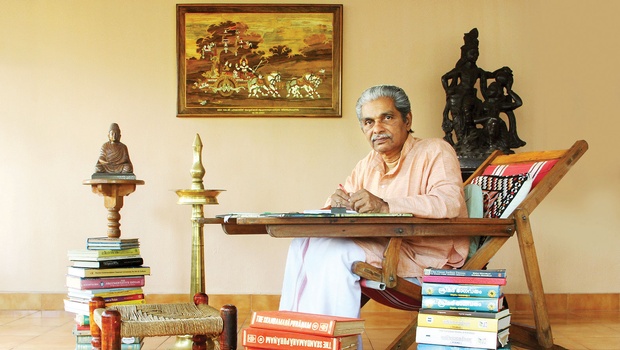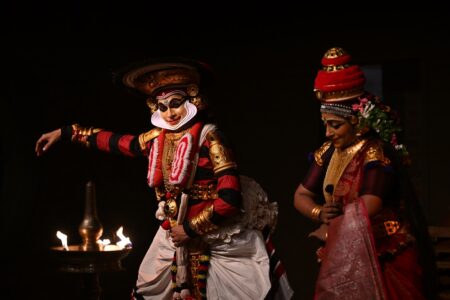Sooraj Nambiar as Dhananjaya in Subhadradhananjayam
The writer, who edited the work Vyangyavyakhya explains the concept of Dhvani and how theatre forms in Kerala deviated from Natyashastra by allowing the actor to transgress the text through transformation of roles and by creating his own text.
Though Bharata’s Natyashastra (NS) was well-known in Kerala for centuries, it may appear paradoxical that the grammar of art forms of Kerala origin like Koodiyattam, Krishnanattom and Kathakali was not in sync with Bharata’s concept. The intrinsic traits of these theatre forms could be explained only on the basis of a tradition esoteric to Kerala. And Vyangyavyakhya (VV) is the answer.
Dhvani in theatre
Bharata’s theatre was very much on the lines of Aristotle’s which entailed staging of the text as it is. The actor is simply an imitator. But in the Kerala theatre forms, we find that the actor transgresses the text through a transformation of roles (Pakarnnattam) and also by creating his own text (Manodharma). This is a contribution of VV. The playwright Kulasekhara of the Chera dynasty was the ruler of Mahodayapuram (Kodungallur) during the 9th century. A renowned scholar of his times, he never wanted his two plays, Subhadradhananjaya (SD) and Tapatisamvarana (TS) to be staged in the conventional Bharata format. What influenced him was the doctrine of Dhvani in poetry propounded by Anandavardhana in Kashmir during the same period, through his work Dhvanyaloka and the commentary to the same, Lochana, by Abhinavagupta. Dhvani implied suggestion and dwelt on that on which the poet was silent. Such an attempt provided immense possibilities for improvisations. Kulasekhara made history by applying the concept of Dhvani to theatre.
The royal dramatist’s court was rich in scholars, astronomers, poets and pundits of NS. He summoned a Brahmin scholar of NS from Parameswaramangalam (North Parur) to his court and enacted the play himself in the new concept. The Brahmin was asked to record the whole performance. This was a defining moment because a performance text was being born for the first time in the history of Sanskrit theatre, that too a thousand years after NS. The manuals were Samvaranadhvani and Dhananjayadhvani. Together they were named VV.
Dhananjayadhvani

I had the privilege of editing Vyangyavyakhya: The Aesthetics of Dhvani in Theatre in 2013 and it was the end product of my assiduous efforts of over two decades and more. Thus the ninth century work in Kerala appeared in print for the first time. More striking is the import of the book, for I am sure it could serve as a veritable guide to practitioners of performing arts of all genres.
In this article, I shall give the beginning of the Dhananjayadhvani. The author begins with the customary invocation; then he mentions the origin of Natya and thereafter gives a beautiful description of the autumn season in Mahodayapuram.
The invocation:
May the elephant-faced God Ganapathy ward off all obstacles that stand on our way:
The God, who in his anger did not hesitate to throw an obstruction even to the heavenly beings fighting a formidable battle in which none other than his father was the warrior;
The very earth with the sun and the moon as wheels on both sides turned out to be the chariot;
The mount Meru forming the bow, the string for which was the chief of the serpents and the arrow, lo! The Lord Vishnu himself
Origin of Natya:
The rays of the rising sun remove darkness from the ‘recess of the universe’
May, likewise, the moon-like lustre of the Goddess of speech dispel the darkness from my heart.
I bow to Sambhu, inseparably united to Uma, who in the beginning created the art of dancing bestowing in it rhythm and emotion to remove the darkness from the minds of the spectators.
Homage to Bharata, the enjoyer of aesthetic pleasure who introduced in this world the art of histrionics as he learned from Brahma who created it.
Observing the canons formulated by the sage King Kulasekhara, endowed with an aesthetic mind, composed two dramas abounding in rhythm, sentiments and suggestive words.

I have, to felicitate a better exposure to the connoisseurs, commented upon the two dramas bringing out fully the suggestive part, the permanent mood and the mode of representation.
What follows is the commentary written by me as directed by him, for one of them Subhadradhananjayam, in tune with these principles.
The autumn season in Mahodayapuram:
Then came the autumnal season with its cool breeze and heat so gentle, water as clear as crystal,
Full-blown white lotuses were seen all around, the fragrance emanated from the flower of Saptacchada perfumed all the quarters of the sky, the climate so moderate – neither too hot nor cool;
Traders roamed about in the street proclaiming, as though, the prosperity of the city.
The row of lotus flowers, bees moving around with the hissing sound tormented the hearts of lovers suffering separation from their dear ones.
The rays of the moon too, dipped in nectar though, melted the hearts of beings
Rice plants bearing ripe corn overhead enhanced the charm of the fields, swans on their way back to Maanasa Lake, moved in the sky, they indeed gave a new splendour to the horizon.
Lustful youth, their hearts melting enjoyed the embrace of the harlots.
Festivals, depriving people of their sins were celebrated in the abodes wherein stood many idols.
(To be continued)





2 Comments
Looking forward to the rest of this scholarly series, including a succint comparison of NS and VV, as well as the current scenario.
This is such a beautifully written and educative analysis. And quite an eye-opener, for me at least, as I had always wondered about the unique and very different kind of aesthetic and performance style that is the hallmark of Kathakali, Koodiyattam, Mohiniaattam and Chakyar Koothu presentations (I have sadly never seen Krishnanattam). The unfolding of the layers of interpretative potential offered by the unusual works that constitute the VV is indeed a revelation, and helps put a lot of aspects of Kerala’s ‘classical’ performing arts in perspective. Thank you, Prof Paulose, for this valuable information, and IAR for bringing it to us. Going to read Part 2 now 🙂